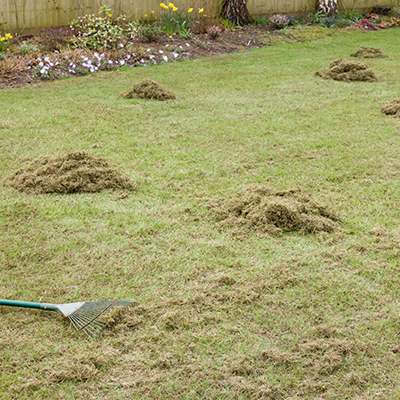You might think it’s far, far too early to consider spring lawn care. Actually, what you do this fall can make or break your lawn next spring. Fall is the perfect time for lawn aeration for a variety of reasons. If you do this now, your grass will thank you later.
Fall Is The Best Time For Aeration – Here’s Why
If you’re not familiar with the process of aeration, it’s a procedure that uses an aerator tool to create thousands of tiny “plugs” of soil from your lawn. This accomplishes two things. One, it breaks up hard, compacted soil to allow air, water, light, and nutrients to get to your grass’ root system once more. Both spring and fall are good times to aerate, but the fall is the clear winner.
Soil Won’t Re-compact Over Winter.
Compaction happens naturally over time due to thatch build-up and foot traffic. The rate of compaction depends on how you use your lawn. For example, if you only walk across your lawn to mow it, your soil will take a long time to compact, compared to playing with your dog and kids on the grass. Since summer is when we spend the most time outdoors, so your lawn is most likely to experience more compaction at this time of year. By aerating in the next month or so, you’ll remove any compaction so that your grass is all set when spring returns.
Fall Aeration Doesn’t Kick Up Dormant Weeds.
When your lawn care services technician aerates, it produces the ideal environment to be receptive to weed control products. This means fewer weeds to contend with in spring. Aerating in spring can bring dormant weeds to the surface to have access to the direct sunlight they need to grow. But aerating in fall is less likely to have this happen because weeds are beginning to go dormant for the year.
Our Cool-Season Grass Loves It
In South Bend, we’re solidly in cool-season grass territory. This means our grasses do best in cooler climates. Grass will, of course, start growing in spring, along with all the other plants, but fall is the season it likes best. Warm days, cool nights, and plenty of moisture to go around – none of those drought-like conditions you’d get in the summer. When you aerate before the first big freeze of winter, this allows your cool-season grass to have maximum root growth before the winter sets in and the growth stops completely.
Attack The Thatch
Thatch is the layer of dead organic material, like dead grass and leaves. Like compaction, it builds up naturally over time, but it can start to smother the turfgrass when it gets too thick. Early fall is when thatch is at its thickest because of all the grass clippings that escape while mowing and the blades that died off from the heat of summer. Leaving this thick layer over winter can really suffocate your grass, especially with all the snow on top of it. By aerating in fall, you’ll literally be giving your lawn room to breathe. Air, water, sunlight, and nutrients will be able to get into the root zone without all the thatch in the way.
Optional: Overseeding
You may not need it, but if you opt for fall aeration and your lawn has thin or bare patches, we can kill two birds with one stone. Thanks to the holes from the aerator tines, the new grass seed can easily establish in the lawn. As mentioned previously, fall is the perfect weather for cool-season grass. Without the high heat of summer, your new grass will have ample moisture to germinate and green up before it goes dormant in winter.
Find Lawn Care Near South Bend, Indiana
Get your lawn prepared for spring by doing it a favor this fall. The aeration service from HydroSeed Inc will rejuvenate your soil and thicken up your turfgrass. This vital service is the reason why golf courses always have pristine grass. By incorporating it into your lawn maintenance program, you too can enjoy lush, thick green lawns. If you’d like to learn more or schedule an appointment, call 800-468-LAWN to speak to an expert or leave us a message through our online form. You can also connect with us on Facebook and YouTube! Don’t forget to visit our blog next month for more helpful information on all things lawn care-related.

